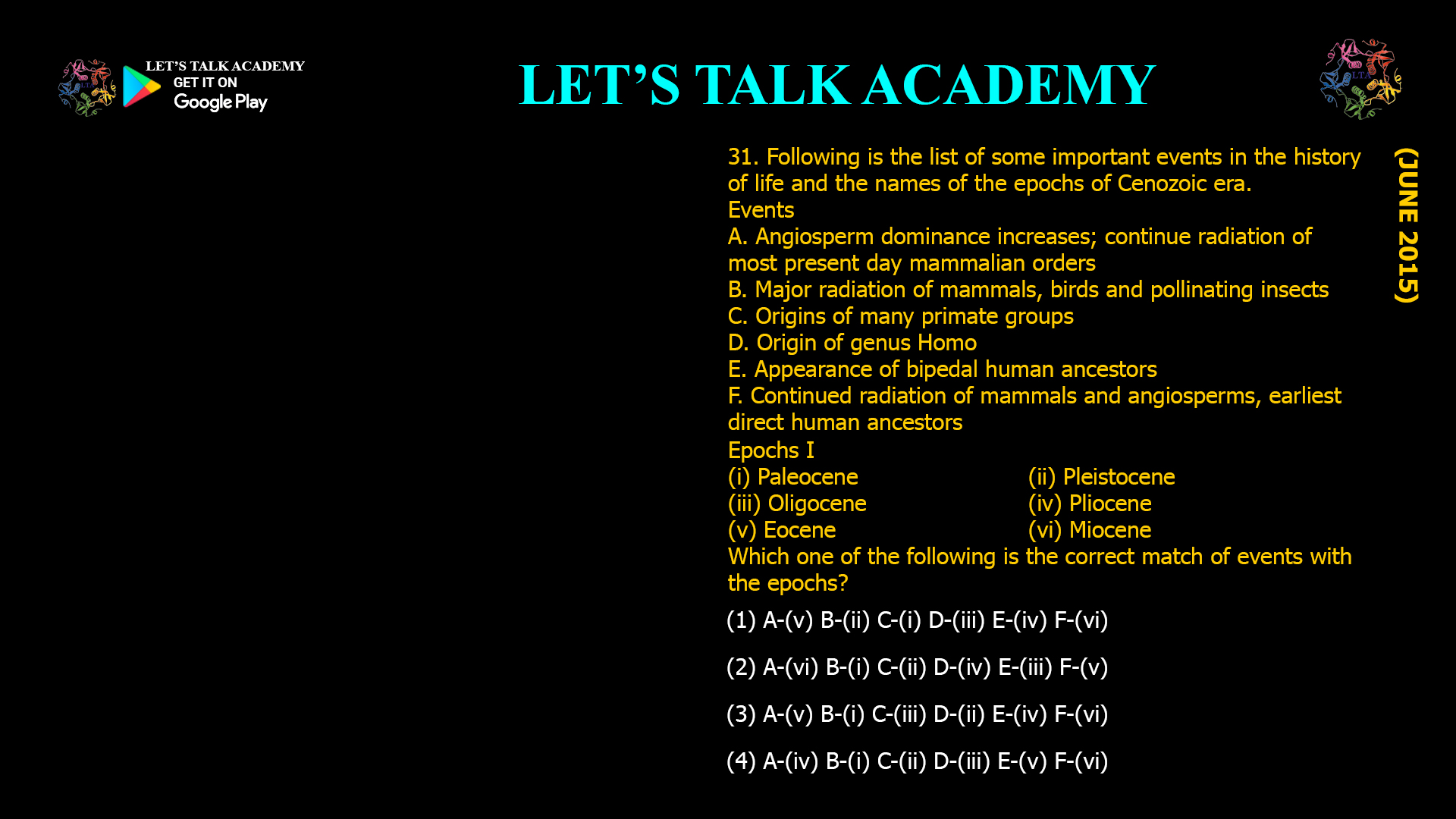- Following is the list of some important events in the history of life and the names of the epochs of Cenozoic era.
Events
A. Angiosperm dominance increases; continue radiation of most present day mammalian orders
B. Major radiation of mammals, birds and pollinating insects
C. Origins of many primate groups
D. Origin of genus Homo
E. Appearance of bipedal human ancestors
F. Continued radiation of mammals and angiosperms, earliest direct human ancestors
Epochs I
(i) Paleocene (ii) Pleistocene
(iii) Oligocene (iv) Pliocene
(v) Eocene (vi) Miocene
Which one of the following is the correct match of events with the epochs?
(1) A-(v) B-(ii) C-(i) D-(iii) E-(iv) F-(vi)
(2) A-(vi) B-(i) C-(ii) D-(iv) E-(iii) F-(v)
(3) A-(v) B-(i) C-(iii) D-(ii) E-(iv) F-(vi)
(4) A-(iv) B-(i) C-(ii) D-(iii) E-(v) F-(vi)Epochs of the Cenozoic Era: Mapping Major Evolutionary Events to Their Geological Timeline
The Cenozoic Era, often called the “Age of Mammals,” marks the most recent chapter in Earth’s history and is defined by the dramatic rise of mammals, birds, flowering plants, and ultimately, humans. Spanning from about 66 million years ago to the present, the Cenozoic is divided into several epochs, each characterized by unique evolutionary milestones. Understanding which events occurred in which epoch is essential for anyone interested in paleontology, evolutionary biology, or Earth’s history.
Let’s explore how some of the most significant events in the history of life align with the epochs of the Cenozoic Era, and identify the correct matches based on scientific consensus.
The Cenozoic Era: An Overview
The Cenozoic Era is divided into three periods and seven primary epochs:
-
Paleogene Period: Paleocene, Eocene, Oligocene
-
Neogene Period: Miocene, Pliocene
-
Quaternary Period: Pleistocene, Holocene
Each epoch is marked by distinct evolutionary developments and environmental changes that shaped the modern world12368.
Key Evolutionary Events and Their Epochs
Let’s look at the major events and their correct placement within the Cenozoic timeline:
A. Angiosperm dominance increases; continued radiation of most present-day mammalian orders
-
Epoch: Eocene
-
Details: The Eocene (about 56 to 33.9 million years ago) witnessed the flourishing of flowering plants (angiosperms) and the continued diversification of mammals into many of the orders we recognize today.
B. Major radiation of mammals, birds, and pollinating insects
-
Epoch: Paleocene
-
Details: The Paleocene (about 66 to 56 million years ago) directly followed the extinction of the dinosaurs. This epoch saw the first major adaptive radiation of mammals, birds, and pollinating insects, filling ecological niches left vacant by the mass extinction.
C. Origins of many primate groups
-
Epoch: Oligocene
-
Details: The Oligocene (about 33.9 to 23 million years ago) is notable for the emergence and diversification of many primate groups, setting the stage for later human evolution.
D. Origin of genus Homo
-
Epoch: Pleistocene
-
Details: The Pleistocene (about 2.6 million to 11,700 years ago) is famous for the appearance of the genus Homo, including Homo erectus, Homo neanderthalensis, and ultimately Homo sapiens.
E. Appearance of bipedal human ancestors
-
Epoch: Pliocene
-
Details: The Pliocene (about 5.3 to 2.6 million years ago) saw the emergence of the earliest bipedal hominins, such as Australopithecus, which are direct ancestors of modern humans.
F. Continued radiation of mammals and angiosperms, earliest direct human ancestors
-
Epoch: Miocene
-
Details: The Miocene (about 23 to 5.3 million years ago) was marked by continued mammalian and angiosperm diversification, as well as the appearance of the earliest direct human ancestors.
Matching Events to Epochs: The Correct Combination
Based on the above, the correct match is:
Event Epoch Option Number A Eocene (v) B Paleocene (i) C Oligocene (iii) D Pleistocene (ii) E Pliocene (iv) F Miocene (vi) This corresponds to Option (3):
A-(v) B-(i) C-(iii) D-(ii) E-(iv) F-(vi)
Why This Matching Is Correct
-
Paleocene (B): Marks the beginning of mammal and bird radiation after the dinosaurs’ extinction.
-
Eocene (A): Flowering plants and mammals diversify rapidly, shaping modern terrestrial ecosystems.
-
Oligocene (C): The rise of many primate groups, including ancestors of monkeys and apes.
-
Miocene (F): Expansion of grasslands, continued mammal and angiosperm radiation, and the earliest hominins.
-
Pliocene (E): Appearance of bipedal hominins, bridging the gap between ape-like ancestors and the genus Homo.
-
Pleistocene (D): The Ice Ages and the rise of the genus Homo, including modern humans.
The Importance of Epochs in Understanding Evolution
The Cenozoic epochs provide a detailed framework for tracing the evolutionary history of life as we know it. By understanding which events occurred in which epoch, scientists can reconstruct the environmental and biological factors that drove the evolution of mammals, plants, and humans.
This knowledge is not just academic—it helps us understand biodiversity, climate change, and the resilience of life in the face of planetary upheavals.
Conclusion: The Timeline That Shaped Modern Life
Matching key evolutionary events to the correct epochs of the Cenozoic Era is essential for a clear understanding of our planet’s recent history. From the rise of mammals and flowering plants to the appearance of our earliest ancestors and the eventual emergence of modern humans, each epoch tells a vital part of the story.
-



